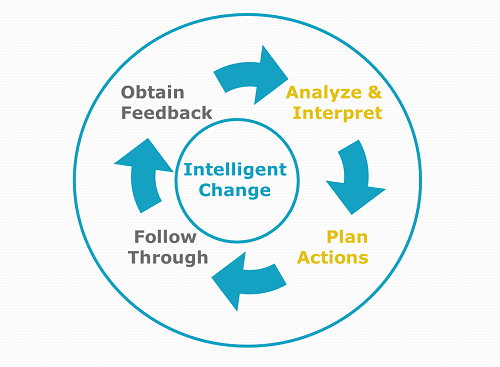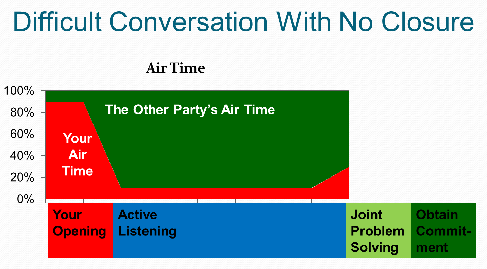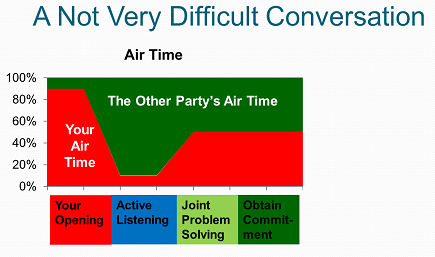When you walk in the room, who shows up for Read more →
Pivot to the Center
Allen Slade
When incumbent presidents run for re-election, they usually win. Of the last 14 reelection bids, 10 were successful. Since 1996, every president has been reelected. Franklin D. Roosevelt’s perpetual reelection led to a constitutional amendment to limit presidents to two terms.
Non-incumbent politicians must capture the partisan base in the primaries. To win the general election, most politicians have to pivot to the center to capture non-partisan votes. The most effective politicial leaders govern for the common good, usually requiring a second pivot even further to the center.
In this presidential election, Obama was able to stay near the center politically. Romney had to execute a difficult pivot to the center. Jacob Weisberg describes Romney’s campaign as a failed pivot to the center:
Romney is not a right-wing extremist. To win the nomination, though, he had to feign being one, recasting himself as “severely conservative” and eschewing the reasonableness that made him a successful, moderate governor of the country’s most liberal state. . . . Romney’s pandering to the base made it possible for the Obama campaign to portray him as a right-wing radical from the start of the campaign. Fear that he didn’t have the base locked down kept Romney from moving smoothly to the center once he had secured the nomination.
A move to the center is difficult. Politicians who espouse extreme views in the primary but switch to more moderate views for the general election are accused of flip-flopping. They appear to be inauthentic.
As a leader, you have to practice principled moderation. As you advance to functional manager, you have to pivot to center, starting to address issues like budget, efficiency and change management. Many of your former peers will resent you.
If you move from functional manager to general manager, you have to broaden your perspective yet again. You will focus on the bottom line, not just functional excellence. You will balance operations, finance, marketing and human resources. Your peers from your former function will resent you.
These pivots to the center will open you to charges of arrogance, lack of authenticity and selling out. As you pivot to the center, you may appear to be, well, a politician.
To ease your pivot to the center as a leader, I offer three suggestions:
Expand your horizon. You will alienate a few people to serve many people. You will sacrifice your personal comfort to serve the greater good. Just as the best politicians move past partisan appeal to win a general election and govern for the common good, you need to move past beyond a limited perspective and your old peers to lead at the next level. Decide to make the sacrifice before you accept the management position.
Take time for sense-making. A pivot to the center is a major career change. Give yourself time to make sense of the transition.
Get coaching. Get objective, independent advice on how to make a successful pivot to the center. Mentors may help a bit, but coaching is better. Get a leadership coach for the change from technical specialist to functional manager. Get an executive coach for the pivot from functional manager to general manager.
A pivot to the center is one of the toughest moves you can make. Growth and change are always tough, but often rewarding. When you have the opportunity, make your pivot to the center to become the best leader you can be.
The Leadership Paradox of Principled Moderation
Allen Slade
I have previously argued that principles of leadership are outdated. These old school principles of leadership – all leaders should be tall, male, Theory Y, 9/9 or whatever – do not tend to maximize your influence in the real world.
I strongly believe that leadership theory has failed to come up with simple, one-size fits all rules for leaders. Because of the nature of leadership science, I suspect we will never have simple principles of leadership.
I am not arguing that leaders should be unprincipled. In fact, there are principles all leaders should pursue: principles of ethics and the principle of moderation.
Moderation is essential for your leadership. Leaders who believe in the one best way tend to drive into the ditch. For example, when making a decision, leaders can interact with their team in a number of ways. They can direct the team to action, consult with the team before deciding, ask the team to participate in the decision, delegate the decision or empower the team to take action on their own. In most organizations, a moderate amount of direction, consultation, participation, delegation and empowerment will work well.
Petronius said “Moderation in all things, including moderation.” Some people refer to this as a paradox. I see moderate moderation as a gentle warning of the dangers of absolute relativity. As a leader, at times you need to be a rock in the storm. You have to take a principled stand. The people you lead expect consistency in your behavior. You will develop your own set of ethical principles. As a thought starter, here are two principles I pursue in my own leadership:
Integrity. When I make a commitment to you, I follow through. I make SMART commitments when feasible, and I keep them. If something changes, I will proactively ask you if we can renegotiate. I do not cross my fingers or give myself a “silent” escape clause that would allow me to avoid you if times get tough. If I fail to keep my commitment, I do three things: apologize, state that it will not happen again and ask how I can make it right.
Appropriate Transparency. I say what I mean and I mean what I say. I let those I lead know about me, while avoiding too much information. I refuse to be interrogated, so I keep confidences with silence rather than falsehood.
Principled moderation is a potent combination. There are certain principles that should run through your leadership, like integrity. Yet, you should be moderate in most things. Your team will know what you stand for, and know that you will adjust your behavior to fit the situation. Then, you will be a rock in the storm and a shining example of moderation.
Principles of Leadership Are Outdated
Allen Slade
When I teach leadership to business students, I often open the first class by asking students about leaders they respect. Mahatma Gandhi, George Patton, Martin Luther King, Jr. and Steve Jobs are often mentioned. Some students talk about their athletic coach or a former boss.
Then, we get to the heart of leadership. To save you the cost of tuition, here are the highpoints:
The “Great Man” theories of leadership don’t work.
There is no one best way to lead. The best way to lead depends on the situation.
The best leaders are not students of leadership.
There are no simple rules. I discourage imitating role models. I attack leadership trait theories. I undermine leadership style theories. Being the best leader you can be is difficult and complicated.
Those who look for simple answers are understandably disappointed.
Yet, there is a straightforward approach to leadership in my class. Be a student of followership and collect lots of data.
Be a student of followership. Don’t waste time studying leaders or leadership. Study the people you lead. The best leaders have incredible curiosity about the people around them. They ask people what’s important to them, then they think hard about the implications. They check for understanding by asking more questions. The best leaders shape their leadership behavior for their followers.
Collect lots of data. To understand people, the best leaders are hungry for information. They collect data with direct observation of the words, tone and emotions of others. They ask lots of questions. And they suck every bit of value out of any quantitative data they can get, through surveys, 360 reports, attrition data, customer data, etc.
For the visually oriented like me, here is how I capture this vision of leadership:
With a commitment to know the people you lead and a hunger for more data, you can bootstrap your leadership. You can create mini-experiments based on your tentative knowledge of people, and then correct your actions based on their feedback. You will develop a personal, flexible leadership style. And, I suspect, your impact as a leader will expand well beyond what you would achieve if you had simply tried to imitate the great leaders of the past.
Managing Negative Deviance vs. Leading with Appreciation
Allen Slade
In our culture, pragmatism runs deep. We see through the lens of problem solving. We look for negative deviance by measuring performance against standards and focusing on shortcomings. We identify weaknesses and we punish shortfalls. We hold others accountable to meet standards. If someone does not measure up, we take corrective action. If someone does meet one set of standards, we look for other areas where they have fallen short.
Yet, as a leader, you are responsible for the debris field of negative deviance. Too much control, too much problem solving undermines your team’s engagement. If you are always focused on problems, your team will lose energy. As I said in The Problem with Problem Solving:
If a given task or situation seems to be laden with problems, you lose energy for that task or situation. External factors (such as a paycheck) may cause you to continue with that relationship, task or situation, but your heart won’t be in it. Excessive problem solving is the problem.
If problem solving drains energy, appreciation builds energy. You must be able to appreciate people and opportunities. You must be able to recognize what is good, true, effective and beautiful. You must reward progress, not just punish shortfalls.
As a leader, what can you do to help your team maintain the right balance between problem solving and appreciation?
One buffer to negative deviance is leading with appreciation. As a leader, you should look for what is good, true, beautiful and effective. You must help your team members leverage their strengths, not just fix their weaknesses.
I encourage you to try powerful questions to lead with appreciation. The right questions can help shift your team’s focus from problem solving to building on what works well. Pull out the positive by asking:
What is going well? What is better than expected?
What are we doing right?
How are we better than the competition?
Where have we improved? What have we learned?
How can we build on our strengths?
Leading with appreciation will help shake your team out of persistent problem solving. Your team will discover best practices and build on existing knowledge. As your team gets better at appreciation, they will discover sustainable success.
You will also see an impact on your team’s energy. People will engage because they are involved in success, not just a series of problems.
As a leader, your job is to manage energy in others. Try less management of negative deviance and more leadership with appreciation. Then stand back and enjoy the sustained power surge.
The Problem with Problem Solving
Allen Slade
“We have a problem.” If someone says that, do you get a sinking feeling? If you bring up problems with your team, do you feel the energy leave the room?
Let me be clear. Problem solving is good. As a leader, you must solve problems. Your ability to find and fix flaws is essential. Leaders need to find the error, reverse the decline, criticize the fault, hold others accountable and hold difficult conversations.
The problem with problem solving is that we use it too much. Relentless fault finding decreases energy for you and the people around you. If you see everything as a problem, you drain your own energy. If a person frequently finds fault with you, you lose energy for that relationship. If a given task or situation seems to be laden with problems, you lose energy for that task or situation. You may need to continue in that relationship, task or situation, but your heart won’t be in it. Excessive problem solving is a problem.
While problem solving drains energy, appreciation builds energy. As a leader, you must be able to appreciate people and opportunities. You must be able to recognize what is good, true, effective and beautiful. You must reward progress, not just punish shortfalls.
To manage the energy of the people you work with, be mindful of your appreciation ratio. The tipping point seems to be 1/3 problem solving to 2/3 appreciation. When problem solving exceeds 1/3 of interactions, we tend to lose energy for that person, task or situation. When appreciation is 2/3 or more, we tend to build energy. Aim for an appreciation ratio of at least 67%.
Managing my own appreciation ratio has fundamentally changed my outlook on life. I used to see consulting as problem solving. If my client hired me to solve problems, then I had to be scanning for problems, thinking about problems, talking about problems and solving problems. With my problem radar on full power, it is no surprise that I found lots of problems. I completed many consulting assignments thinking “With all these problems, I’m glad I don’t work here.”
Now, I look at my clients from the perspective of success. I look for my client’s strengths – what is good, true, effective and beautiful about what they do. With my appreciation radar on full power, I appreciate my clients more and I project a positive vibe. I still solve problems, but I solve them in an atmosphere of appreciation. Now, when I complete an assignment, I think “This is a great company!”
There is a strategic problem with a low appreciation ratio. Focusing on strategic weaknesses is more than depressing. It is bad strategy. Ford Motor Company got into retail banking in the late 1980s and 1990s. Ford was good at car loans and leasing, but it was not very good at retail banking. A problem solver would work on banking until it was fixed. Ford tried to turn the banks around for a few years , but the company wisely decided to cut its losses and sell the banks. Then, Ford was able to focus on its core competencies in auto financing and manufacturing.
Try a mini-experiment today: focus on what is good, true and effective. Look for strengths more than problems. When you interact with people, notice your appreciation ratio. When it drops below 67%, turn down your problem radar and turn your appreciation radar on full power. In the short term, you will perceive things more positively. In the long term, you will build stronger people, more effective systems and a healthier organization by leveraging competency rather than focusing on failure.
To solve the problem with problem solving, go positive. Problem solve less and there won’t be as many problems. Appreciate more, and you will build your success as a leader.
Balancing Airtime in Your Meetings
Allen Slade
Some people think meetings are just a waste of time. At one level, meetings exist to share information and to make decisions. (It doesn’t always work, but that’s the plan.) At another level, leaders should see meetings as leadership development opportunities. Jim Clawson says effective leadership is “managing energy, first in yourself, then in those around you.” In a meeting, energy shows up most clearly as spoken comments. One way to think about managing the energy in meetings is airtime.
Airtime is the percent of time you are the focus of the team’s attention (talking, writing on the board, etc.). For a five person team with equal attention, each person should be the focus of attention about a fifth of the time – 20% airtime. A person dominating the conversation has 50% or more airtime.
It is rare that each person gets exactly the same airtime in a meeting. You may have more airtime because your expertise or passion fits the topic.
Once you get a handle on your own airtime in meetings, notice the airtime of the people around you. Some people may dominate the meeting (take up most of the airtime) while other people almost never speak. In some meetings, unbalanced airtime makes sense. The high airtime person may have unique information or expertise that will help move the meeting ahead.
All too often, though, unbalanced airtime comes from ineffective meeting dynamics. There may be personality differences that drive airtime, such as extroverts speaking endlessly and introverts staying quiet. There may be cultural norms that prevent some from speaking up, such as power distance or gender roles. There may be managers who love to hear their own voice. There may be politics at work, with the deliberate attempt to keep certain ideas or people out of the discussion.
If you want to balance out airtime, here are some tactics:
Draw in the silent majority. Ask a quiet person a direct question. Often, when you break the ice, they will find it easier to participate in the future.
Gently redirect dominators. If someone takes up too much aritime, use an appropriately assertive statement such as “Let’s hear from some other people now.”
Restructure the conversation. Try beginning the meeting with an icebreaker exercise or by asking everyone to briefly report on activities or results. During the meeting, ask everyone to comment on the issue or decision.
Get a facilitator. If the meeting continues to be ineffective, look to bring in a facilitator. The facilitator can help you redesign the meeting beforehand. He or she can also help with in-the-moment interventions to get the meeting rebalanced.
When managing airtime in your meetings, you are not striving for perfect balance. Instead, you are looking to get everyone engaged in the meeting. Balanced airtime will make meetings more interesting. It will help your information sharing and decision making more effective. Balanced airtime will maximize leadership development of others. And, actively managing airtime for yourself and others will become another tool in your leadership toolbox.
Test Your Ejection Seat
Allen Slade
Felix Baumgartner’s space jump had a dramatic buildup to a truly amazing physical feat. The video of Baumgartner spinning and tumbling at 700 m.p.h. is heart wrenching. And it ended with a perfect landing.
However, the “mission” was presented as a NASA-like experiment to make space jumping viable for escaping from a space vehicle. The mission was not very NASA-like. The flight director was no Chris Craft. And Baumgartner is an extreme athlete, not an astronaut. His poor checklist discipline and his concern with styling his hair after removing his helmet was more Tom Cruise than Alan Shepherd.
My father, Harry Slade, worked at NACA/NASA from the beginning of the jet age through the space shuttle. And, in 1976, in the New Mexico desert, he helped test one of the oddest emergency systems in the world: a helicopter ejection seat. How does Baumgartner’s space jump compare to a helicopter ejection seat?
The best ejection seats are virtually automatic – pull one lever and hang on. Baumgartner’s exit was slow and difficult: a long checklist and keeping his cool while tumbling at 700 m.p.h. But Baumgartner did not jump from a hypersonic spacecraft. He bunny hopped from a capsule floating gently beneath a balloon.
Space jumping will require more planning and testing before it provides real safety. In an emergency space jump, the craft would probably be spinning, disintegrating or on fire. A Baumgartner-like jump would be too complex and too physically stressful for a space tourist to survive.
NASA’s helicopter ejection seat was not like the space jump. The ejection seat was for a helicopter testing next generation rotor blades. Test rotors were thinner and lighter, increasing the risk of failure. Rotors are most likely to fail during takeoff and landing. A pilot could not eject down because of the low altitude. The pilot cold not eject sideways either, because rotor debris would be spiraling to every point of the compass. The ejection seat had to go up, through the path of the rotors. The ejection sequence was complex: pull the ejection handle, blow off the rotors with explosive bolts, blow the hatch, eject the seat, cut the seatbelts, then deploy the parachute. Asking a pilot to remember these steps during a crash was a recipe for failure. The pilot’s only job was to pull the ejection handle and let the automatic system do the rest.
For leaders, when the crisis happens, it is usually too late to build an ejection seat. When time and tempers are short, people go into survival mode. The brain shuts down cognitive processes, attention narrows and choices seem limited to fight or flight. What backup plans do you need to create? Your leadership crisis may be the loss of a key employee, an unexpected customer request, failure of essential equipment or overload of a critical operation. If the crisis happens quickly, you need to already have an ejection seat.
For a job interview in 2002, I made a presentation on leadership. I emailed my presentation to the host. By plan, I arrived 15 minutes early to check the room. When we turned everything on, my presentation was not on the laptop and my host did not know how to transfer the file. (It was 2002.) No problem – I had a floppy disk. (No USB in 2002.) She found an external disk drive, but the drive did not work. No problem – I had transparencies. They found a dusty overhead projector. When we turned it on, the bulb did not work. No problem – I activated the built in back up bulb. The second bulb worked. I tested the projected image, focused the projector, focused my emotions and was ready to go. (I had one more backup if the second bulb blew – use the whiteboard.) The presentation went well, and I was offered the job.
Lesson #1: For critical activities, have multiple backup plans before the crisis.
The helicopter ejection seat offers another lesson. My dad was in New Mexico to test the seat. The helicopter was bolted to a jet sled, accelerated to flight speed, then a test dummy was ejected. The first test was almost right. The rotors did not blow off before the seat was ejected, shredding the test dummy. (A watching test pilot walked away saying “I’m never flying that bird.”) The NASA team found and fixed the flaw in the timing circuits. All the other tests were successful.
When I joined Microsoft in 1999, my key task was to make the employee opinion survey a success. The 1998 survey locked up because of overloaded servers at the survey host. Under my direction, we created backup plans for every problem we could imagine. More importantly, we tested our back up plans. We did load testing, usability testing, data integrity testing and translation testing. We even tested our testing. In effect, we accelerated the survey to flight speed and pulled the ejection handle. The testing identified problems that we fixed, then we tested to the point of repeated perfection. The actual survey went well – on time, with virtually 100% uptime.
Lesson #2: For critical activities, test your backup plans before the crisis. Make the tests as realistic as possible. And test your tests.
As a leader, what are your key processes? How can they fail? What are your plans for overcoming failure? And how well tested are those plans?
Don’t rely on extreme leadership ability in a crisis. Few of us can tumble at supersonic speed like Felix Baumgartner. Plan for failure and test your plans until you know your ejection seat will save the day.
Are You Just Showing Up?
Allen Slade
You probably had at least one meeting today. Why were you in that meeting? Woody Allen said “90% of life is just showing up.” He’s wrong. Leaders go to meetings to make a difference.
A meeting is like a journey:
You can focus on your next step, looking to avoid a misstep. This short range focus may help you avoid gaffes, but you won’t make much of a difference.
You can think about the next mile – how will we reach our goal for today? With a medium range focus, you can help make today’s meeting a success.
Or you can look to the horizon, and think about where you want to be in the future. With a long range focus, you are looking ahead to future meetings, future decisions and future leadership opportunities. You treat each meeting as an opportunity to grow your influence.
The best leaders do not choose between short, medium and long range focus in a meeting – they do all three at once. They craft a great comment while avoiding gaffes, they make today’s meeting a success and they develop their leadership, all at the same time.
Let’s focus on the long range impact of your meeting participation. As a leader, you should be mindful of your leadership presence in meetings. Do you appear timid? If so, you may not be seen as a leader. Do you talk too much? You may undermine your standing as an empowering leader or an effective team player. Let me suggest three ways you can be mindful of your meeting behavior.
1. If you want to manage your leadership presence in meetings, try noticing how much airtime you take up in meetings.
Airtime is the percent of time you are the focus of the team’s attention (talking, writing on the board, etc.). For a five person team with equal attention, each person should be the focus of attention about a fifth of the time – 20% airtime. A person dominating the conversation has 50% or more airtime.
It is rare that each person gets exactly the same airtime in a meeting. You may have more airtime because your expertise or passion fits the topic.
The point is not to set a specific percentage target. Just notice your airtime.
“Noticing airtime” is not a smart goal. It is not specific, measurable, actionable or time-bound. I am a big fan of smart goals as a powerful source of change, but they are not the only way to develop your leadership. Sometimes just noticing something – being mindful – is all that is needed to trigger a major behavioral change.
2. If the airtime goal doesn’t lead to the change you want, try the rule of three: “I will make 3 valuable contributions in every meeting.” For this to work, you need to do your homework. Study the agenda, do some research, collect some reports and prepare to make a difference.
3. For maximum impact, create a SMART goal. Decide on a plan for your participation in each meeting that is specific, measurable, actionable, realistic and time-bound. For example, “In next Monday’s meeting, I will comment on the product quality topic on the agenda. In advance, I will analyze some data and prepare a customer story. I will practice using both the data and the story with my coach before the meeting. I will use the data, the story or both in the meeting.”
See each meeting as a leadership development opportunity. Stay focused to make a difference. Avoid missteps, push the decision ahead and grow your leadership all at the same time.
Holding a Difficult Conversation
Allen Slade
You are gearing up for that difficult conversation. It may be about a broken commitment, setting a boundary to halt abusive behavior or feedback that is unexpected and unwanted. You want to navigate the emotional minefield to minimize the chance of a catastrophic explosion.
Now what? How do you plan the difficult conversation for maximum gain and minimum risk?
Start with the end. In a previous post, I recommended planning your difficult conversation by starting with the end. Have a clear definition of success. Be sure the potential reward of the difficult conversation is worth the cost.
Don’t procrastinate. Bad news is like bread. It is best fresh. After a few weeks you don’t want it in the house. If you need to have a difficult conversation, do it sooner rather than later. If you need time to think and plan or if you want to check your plan with a coach or mentor, fine. But think of waiting hours or days, not weeks or months.
Begin well. Plan your opening statement. Make it appropriately assertive, following this pattern: When you [specific behavior, attitude or thinking pattern], it makes me [specific negative outcome.] Here are some examples:
“When you roll your eyes while we talk, I feel disrespected.”
“When we discuss customer complaints, you tend to blame other employees. This makes me think you don’t see a need for change.”
Listen more and talk less. Be curious about the other person’s reaction. Look to discover why they act/feel/think like they do. Don’t argue. Don’t project an attitude of certainty. Practice active listening by reflecting back what they say and asking lots of clarifying questions.
Anticipate their reaction. At a basic level, put yourself in their shoes. If you were on the receiving end of this difficult conversation how would you react? Even better, figure out the other person’s general pattern of responding to feedback. Do they have a problem with feedback or are they generally open to feedback? Then, prepare for their reaction. Control your emotions, listen without agreeing and keep the conversation moving ahead to address the issues.
Seek mutual problem solving and commitment. The goal of a difficult conversation should be intelligent change. To change, you need to work with the other person, first to figure out how to change and then to get a commitment to change. You should aim for a smart request, a specific, measurable, actionable, realistic and time-bound proposal that the other person accepts.
When you are at your best as a leader, your difficult conversation should follow this pattern.
You will give most of the airtime to the other person. Only during your brief opening will you do most of the talking. The longest part of the conversation is your active listening, where you may do 10% of the talking or less. When you get to joint problem solving and mutual commitment, you should look to do 50% or less of the talking.
Let’s be realistic. Some difficult conversations do not end with a solution. The other person may be too stubborn. If you do your part well, but the other person resists your efforts, your difficult conversation may turn out like this.  This is not necessarily a bad outcome. For many, being confronted with a shortcoming is shameful.
This is not necessarily a bad outcome. For many, being confronted with a shortcoming is shameful.
I had a difficult conversation with an intern that started: “Dolly, your work has been slipping recently. Several people have reported smelling alcohol on your breath. I am concerned about your reputation. I am reluctant to assign you to important projects or have you go to meetings without me.” Dolly never admitted to a drinking problem. She did not agree to seek help. Yet, the issue disappeared overnight. When her internship ended months later, I gave her high performance ratings and a stellar recommendation.
If the other person has difficulty admitting a personal failing, there can still be change, but it will follow a different pattern. The individual you confront may go back to their office and think about what you said. Sometimes, that triggers the change you seek. They may never admit you were right or confess their shortcoming. That’s OK. You can live with the change even if you don’t get the apology.
The worst case is that change does not happen. Let’s acknowledge that we are dealing with adults. You can’t make the other person bend to your will. Give it your best shot – hold the most effective difficult conversation you can – but accept that they must decide whether to address your concerns. If they do not change, you can make other moves. You can set boundaries, end the relationship or get others involved in resolving the situation. Your key responsibility is to have the best difficult conversation you can without pretending you can control the other person’s reaction.
I have coached many clients on how to hold a difficult conversation. We work together to craft a powerful opening. We practice listening. We practice managing emotions. We even role play the difficult conversation. And then, my client goes off to hold the conversation. Surprisingly often, my client is surprised because the conversation turns out to be not very difficult at all.
 Most adults like to be treated like adults. When your difficult conversation begins well, your appropriately assertive statement can quickly lead to a heartfelt apology and a sincere commitment to do things differently. That’s intelligent change at its best. Prepare well. Expect difficulty and you may be pleasantly surprised.
Most adults like to be treated like adults. When your difficult conversation begins well, your appropriately assertive statement can quickly lead to a heartfelt apology and a sincere commitment to do things differently. That’s intelligent change at its best. Prepare well. Expect difficulty and you may be pleasantly surprised.
My thanks to executive coach Art Gingold for refining my thinking on difficult conversations.
Planning a Difficult Conversation? Start with the End
Allen Slade
You need to have a difficult conversation.
You know the conversation I mean. The conversation you keep putting off. You get butterflies just thinking about it. You know it will not be pleasant.
Your difficult conversation may be confronting someone about broken promises. It may be setting a boundary with someone who tramples over you or other people. You may be planning to share feedback that is unexpected and unwanted. Whatever the topic and whoever the other party, your difficult conversation feels like stepping into an emotional minefield.
As a leadership coach, I help clients hold the difficult conversation they have been putting off. To increase the odds of success, we work on two things: planning the conversation backwards and designing the conversation for maximum impact. Today, let’s think about how to plan your difficult conversation backwards. In other words, the best difficult conversations start with the end.
 In planning a difficult conversation, always plan backward. Define a successful outcome for the difficult conversation before you hold it.
In planning a difficult conversation, always plan backward. Define a successful outcome for the difficult conversation before you hold it.
What does success look like? What change would you like to see in the other person? It might be a change in behavior, such as an employee returning phone calls promptly. It might be a more subtle change in thinking, values, attitudes, beliefs or expectations. Sometimes your desired change is not in the cards – the other person does not share your motivation, your definition of success or your norms. Sometimes, the endgame is just not feasible.
Is it worth it? How much risk will you take? Some difficult conversations put your relationship at risk. While things may improve, you can also harm the relationship by opening emotional wounds. A difficult conversation can also harm your credibility with your wider circle of influence. You must decide if the probable pain is worth the potential gain.
Starting with the end will show you a lot of difficult conversations should not happen:
Don’t tilt at wind mills. Risking much with little odds of success is not a good bet. Don’t confront your boss during your performance review meeting, especially if you expect poor ratings. Don’t ask the CEO snide questions during the strategy rollout. Don’t voice complaints about the company on your last day of work. If you don’t have the standing to make a positive change, save your energy and your reputation.
Don’t do it to let off steam. Don’t hold a difficult conversation because you “have” to tell them something. If you are holding a difficult conversation to vent your frustration, punish the other person or get something off your chest, just don’t. Unless you can visualize a successful change in the other person, don’t start a difficult conversation. Talk to your therapist, write in your journal or yell in your private closet instead.
Don’t call out strangers. Grocery store parenting advice, barroom etiquette instruction and roadway driver’s ed rarely stick. Worse, strangers can react strangely with nasty expressions, verbal abuse or violence. Little upside and potentially grave downside make difficult conversations with strangers a bad bet.
By avoiding fruitless difficult conversations, you will be happier and healthier. You will also have more energy for the conversations that have the right end game. Then, with the proper planning, you can improve a relationship, change someone’s ineffective behavior or chart a new direction. You can have difficult conversations with the outcomes you seek, if you start with the end.








